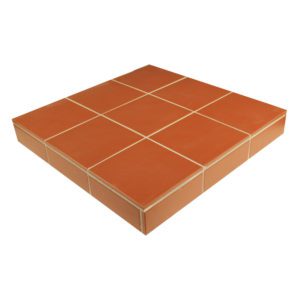Victorian Floor Tiles
Our range of ceramic period tiles for floors allowing you to create a stunning porchway or hall entrance to your home
Buy Victorian Floor TilesWe supply a number of ranges or floor tiles, from our popular Westminster range of Victorian floor tiles to our new ranges of encaustic style porcelain tiles; Capital, Calais and Sorbonne. We also supply step treads for added security in areas where anti-slip performance is essential.
Floor tiles fall into two categories – ceramic and porcelain. Firstly, the raw materials to create the tile need be found. Both porcelain and ceramic tiles use various forms of clay in their creation.
Porcelain tiles usually use heavier, denser clays than a typical ceramic tile. The hard clays used for porcelain tiles tend to be white clays which are mixed with sand and feldspar.
The dense materials that are used in porcelain tiles are particularly suited for their application as floor tiles. This is because they absorb significantly less water than ceramic tiles and are able to resist stains. While this makes them ideas for shrugging off the muddy paw-prints of the family dog in November, there are difficulty inherent in manufacturing porcelain tiles due to their density and hardness. These properties also make them quite brittle and difficult to cut.
In order to produce a porcelain, the clay is collected; crushed to break up any bulky pieces then sent to a milling machine where the pieces are ground into the consistency of sand. This process enables the clay to mix more effectively with the other key ingredients of sand, water, feldspar, along with other chemicals which vary, depending on each company’s unique formulation.
Once a suitable mixture is created, all air must be removed from the mix as air bubbles developing in the tiles can seriously impact their durability. For this reason, as soon as the air is removed, the dense clay mixture is forced through a metal die. This forces the clay to exit in a long thick sheet. This particular process is known as “extrusion”.
After the extrusion takes place, tiles are then punched out of the extruded layer and fed through a drying process. This removes a certain amount of moisture from the tiles. Removal of moisture is an essential part of hardening and strengthening floor tiles to be ready for use, and consequenty, this step is repeated.
In the next step, the tile is primed ready for its pattern. This starts with the addition a base coat of paint. It is then followed by the application of a primer coating which ensures that the ink sticks to the tile appropriately. Finally, once the floor tile has received both its primer and its paint, it requires a protective glaze which protects the pattern from wear.
In the last stage, the porcelain floor tiles are sent to the kiln. Here, temperatures of 1185 degrees are applied to draw out the very last moisture that might still cause weakness in the floor tiles. At the conclusion of the process, tiles are taken through a slow cooling process. This is an essential part of the process and it can lead to the tile exploding due to temperature shock if cooling is improperly handled.
Ceramic tiles follow a similar process to the porcelain tiles up till the extrusion process. From this point, instead of being fed through a die, the ceramic tile mixture is poured into a mould and then pressed into the correct shape. This is possible because the clay used for ceramic tiles is more ductile and less liable to crack under the pressure than porcelain. Once the ceramic tiles are pressed, they rejoin the porcelain tiles for the rest of the process to be painted, dried, fired in the kiln and packaged for export.
